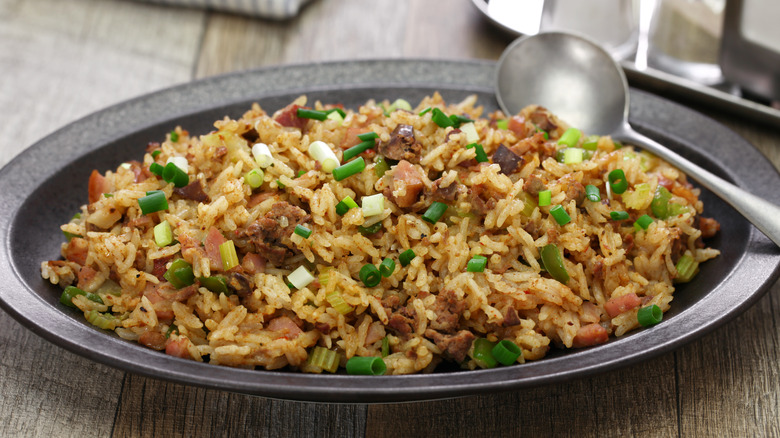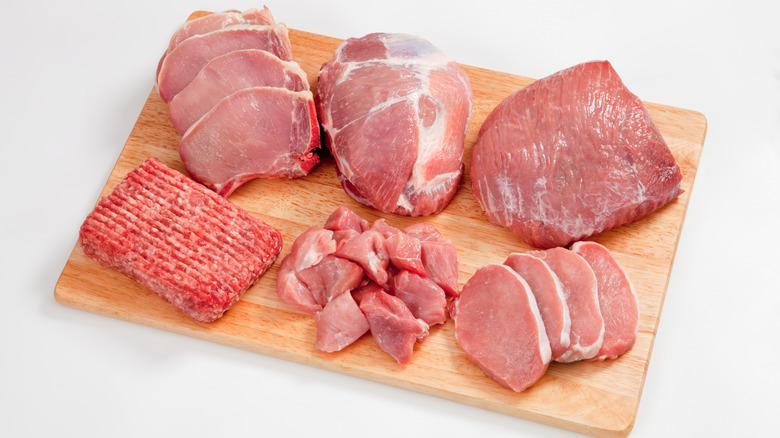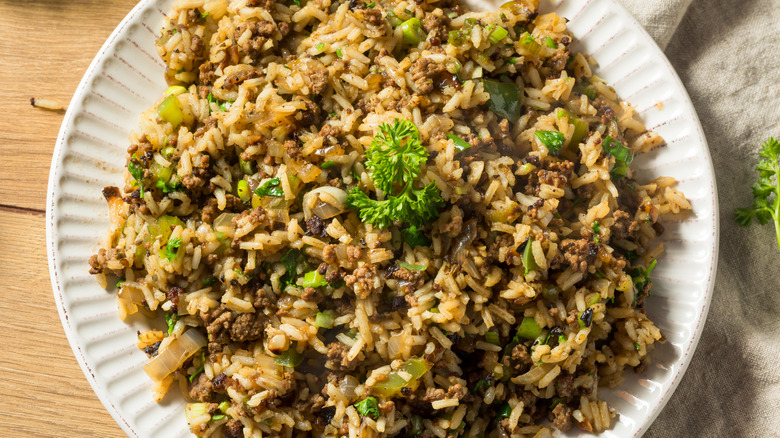What's The Best Type Of Meat To Use For Dirty Rice?
Dining in Louisiana, you're sure to come across dirty rice on the menu before long. This Cajun-style rice and meat dish is simple but full of savory, spicy flavor that'll have you piling it up on your plate. The word "dirty" in the name comes from the brown color of the rice, which itself is derived from the combination of finely chopped meats and vegetables that go into the dish, alongside ground spices. The rice is cooked in chicken broth for extra flavor, then sprinkled liberally with Cajun seasoning (which contains paprika, cayenne, and both garlic and onion powder, among other spices).
Traditionally, dirty rice is made with a medley of different meats that vary from recipe to recipe, though the ideal meat to use depends a lot on how authentic you want the dish to be. While many modern dirty rice recipes ask for ground beef or may even request sausage or bacon, pork is typically a more common protein in Cajun cooking. Notably, chicken livers or chicken gizzards are almost always on the ingredients list as well. These organ meats are arguably the most necessary component to make the dish authentic and will provide a delicious depth of flavor when combined with the other ingredients.
Pork vs. beef: which is better in dirty rice?
There's debate over whether ground pork or ground beef is truly the "authentic" addition to dirty rice. However, both appear to be fairly widely used — and each protein has its own merits.
Pork is already pervasive in Cajun cooking, making it an obvious choice — pork and pork byproducts feature in jambalaya, gumbo, red beans and rice, and many more classic Cajun recipes. While pork in Cajun recipes typically comes in the form of andouille sausage – spicy cased meat made with the stomach and intestine of pigs — ground pork or pork sausage is ideal for dirty rice specifically; adding slices of andouille to dirty rice will make it more of a jambalaya (though jambalaya, for the record, does have quite a few extra ingredients beyond dirty rice, including the addition of tomatoes and a different array of herbs). Ground pork is also often cheaper than ground beef, making it the frugal option.
Beef is a little less common in Cajun cooking, but the protein still makes an appearance in some recipes. Beef will impart a slightly different flavor to the rice; it's not as mild as pork, so the finished dish will be a little deeper in flavor. Beef is also a darker meat than pork, which will give the finished rice a richer brown appearance. If beef is what's in your fridge, we say use it — dirty rice is all about using what you have on hand.
Using the scraps to stretch a meal
Dirty rice was born of necessity and has its earliest roots in slavery. Enslaved Africans in Louisiana who were forced to grow rice on the plantations helped the meager meals go further by combining rice with the butchering "extras" they were provided. This tradition of using whatever was on hand to make rice go further continued with the Acadians – early French settlers who adapted their beloved recipes to the ingredients they could easily find in the region.
The Acadians, from which we get the word Cajun, were not well-off people, and when food needed to be stretched, plenty of extra ingredients were added to the pot to ensure stomachs didn't go empty. In the Gulf area and the bayous of Louisiana, seafood like shrimp and crawfish were plentiful, chicken and pigs could be raised, and rice was an easy crop to grow, making these all staples of Cajun cooking. To stretch things further, families also tossed in whatever they had available at the time, particularly their scraps and inexpensive cuts of protein: organs, ground meat, and sausages. For truly authentic dirty rice, high-quality cuts of meat just won't meet the mark.
While not everyone's cup of tea, add-ins like the liver or gizzards impart that characteristic hint of gamey earthiness to dirty rice without overpowering the other components. Using one or both of these organ meats alongside your preferred ground meat is ideal for a delicious (and authentic) outcome.


